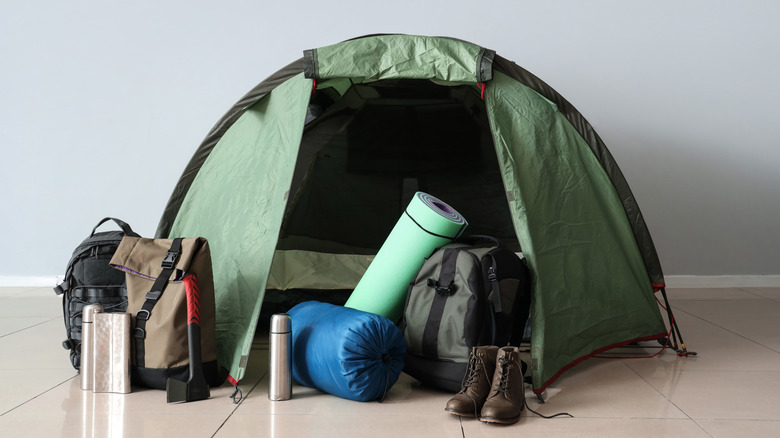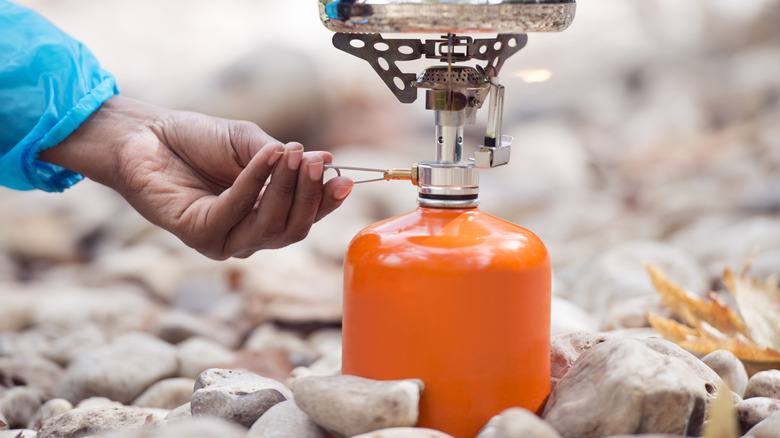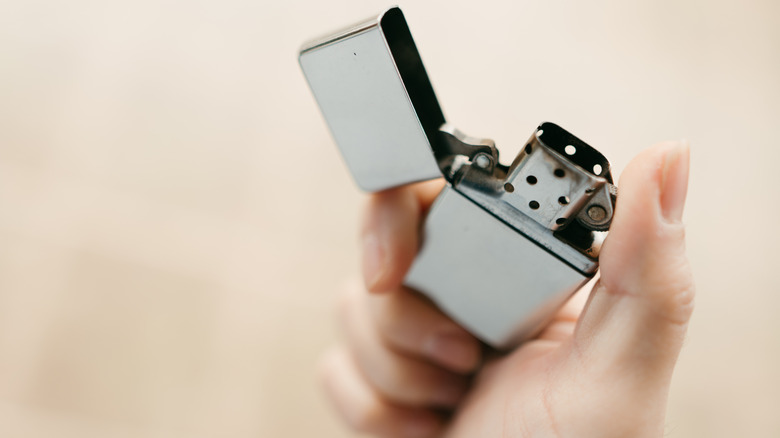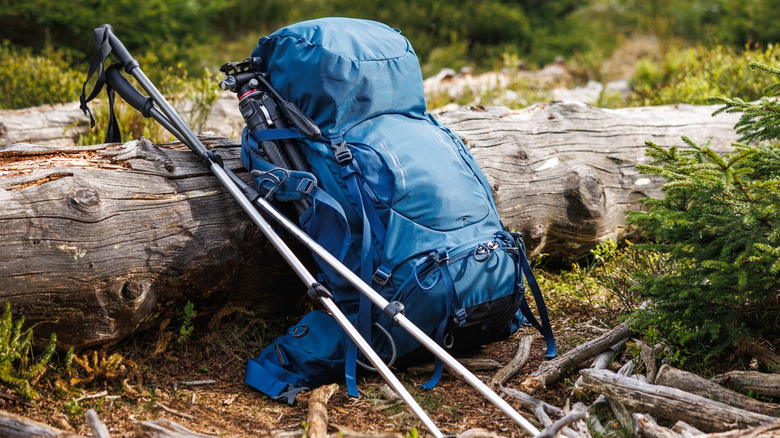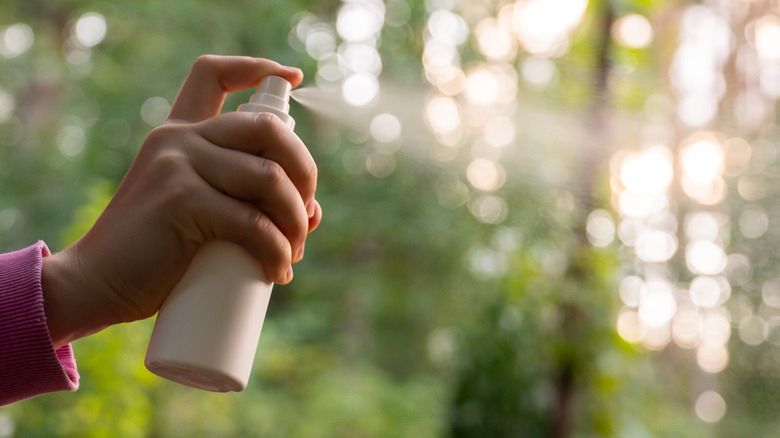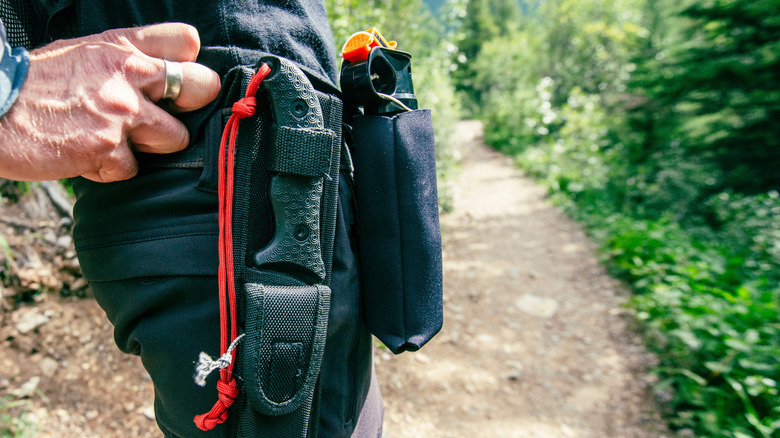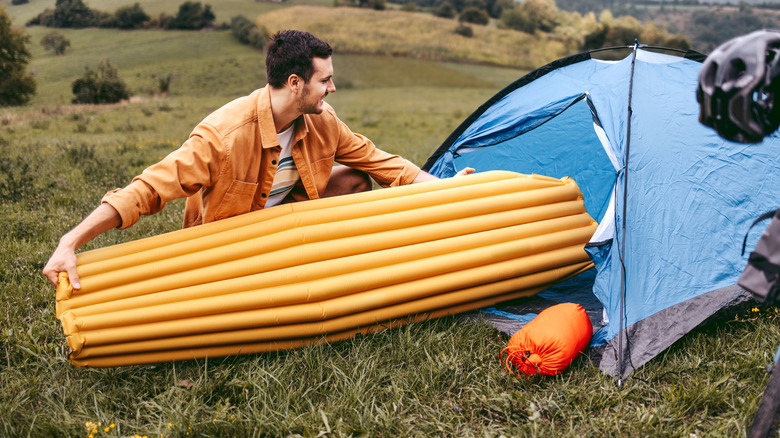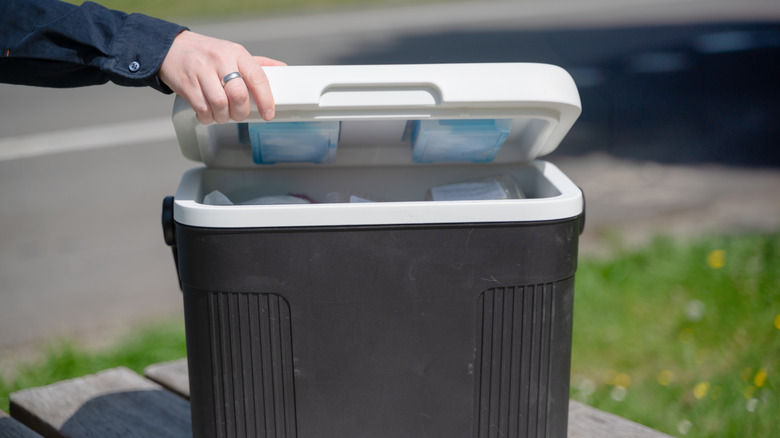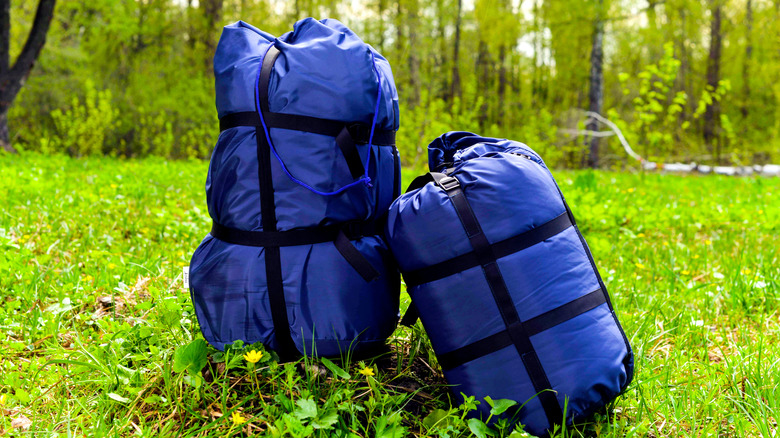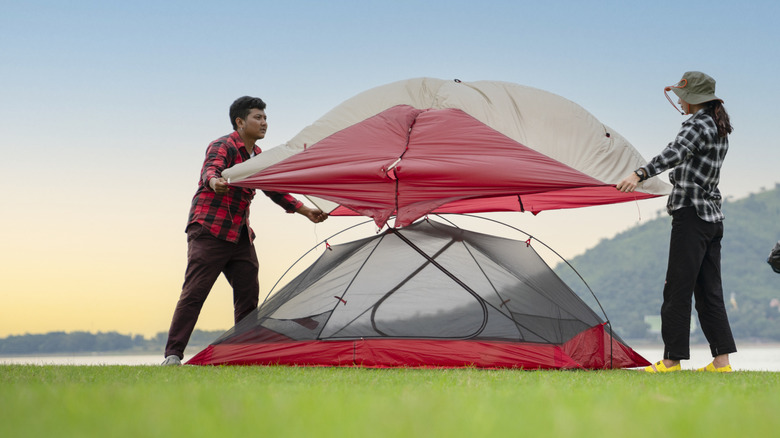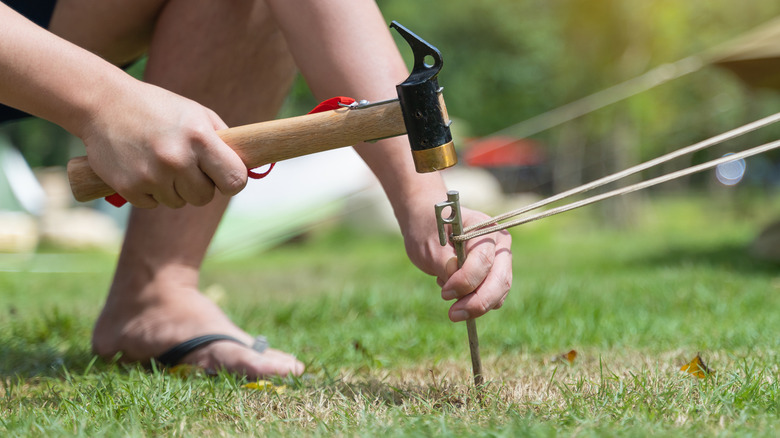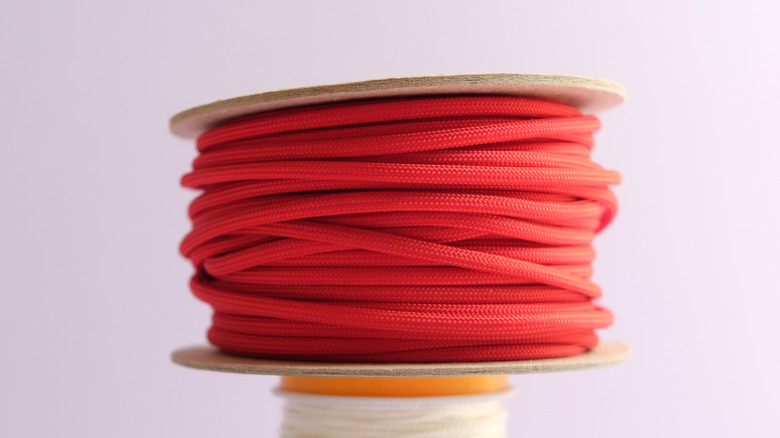15 Camping Items And Their TSA Restrictions To Know Before Flying
Many people think of camping as an activity to do when staying close to home or maybe even on a road trip through America's best national parks. However, there are plenty of beautiful camping destinations worth taking a plane to get to. Imagine nights under the stars on a tropical island, or cooking up some dinner within view of the Swiss Alps, and if you're an experienced camper with an arsenal of gear, you might even have a few other dream campsites in mind. Although it's possible to rent gear when you get there, there's value in bringing your own — but will you be able to get it through TSA?
Camping items tend to be sharp, bulky, and even flammable, which is sure to set off alarms with airport security. Save yourself from getting pulled aside at TSA security checkpoints and read up on the rules about which camping gear you are and are not allowed to pack on a plane.
You might be surprised at which items are cleared for carry-on, while others are only allowed if you pack them in your checked bag. This means you may need to find a lightweight alternative, or accept that you'll need to buy or rent them when you land. Here are the TSA rules for 21 common camping essentials, along with a few ideas to help you get through security smoothly and without any issues.
Knives and Multi-Tools
Sharp objects like knives and multi-tools are useful for numerous tasks around the campsite, from food prep to rope cutting, but they're not allowed in your carry-on bag. However, you can pack them in your checked luggage. Truly something every camping enthusiast should have packed away is a good multi-tool, and ideally one that you know works for your camping style. This is worth checking a bag for, and if you can, try to keep it in its original case so it's easily identifiable in case TSA needs to search your bag. At the very least, sharp edges should be wrapped up in a sheath or secured with cloth.
If you're not that fussy about camping knives or multi-tools, you can try buying a cheap one at your destination, or even order it online ahead of time to be delivered to a pick-up point after you arrive. When traveling abroad, make sure to check the local knife laws. Many countries have strict rules about blade length and locking mechanisms, so a small folding knife may be better to travel with.
Camping Stoves
Cooking over a camping stove is a much safer alternative than traditional campfires. Indeed, some campsites require you to use camping stoves to do all your cooking. These tools come in all shapes and sizes, but thankfully, they're allowed to travel in either your carry-on or checked luggage, as long as all the fuel has been emptied out and cleaned. The TSA also asks that you wrap cords and organize separate pieces so they can get a clearer view of all the items.
If you don't have a camping stove yet, consider that some stoves can be incredibly small and portable, being designed to fit on top of a fuel canister. These will be perfect for a carry-on-only trip since you won't have to worry about emptying anything. If you do need to empty your stove, make sure to do a thorough job and inspect it for any lingering traces of fuel. TSA might confiscate it if they detect even small amounts.
Fuel Canisters
You might have a gas canister lying around from your last camping trip, but you'll need to forget about it if you're taking a plane. TSA agents only make exceptions for personal oxygen cylinders for medical use or empty compressed gas cylinders, but a full can of flammable gas is a no-go. Thankfully, this is not such a difficult item to find after you land, especially if you are going to a popular camping destination. Research local sporting goods stores or call ahead to the campground to see if they offer any canisters for sale in their shop. Worst-case scenario, you could also order one locally to be delivered to a pick-up point.
Before you go, make sure you know which kind of fuel your stove uses and research whether you will be able to buy this if you're traveling internationally. You can also buy a universal adapter or a multi-fuel stove that works with different canister types.
Matches
Safety matches are allowed in both your carry-on and checked luggage. These are the typical matches you'd find in a matchbox or in a matchbook, designed to only ignite when struck against a specific surface. Strike anywhere matches are different because they will ignite when the chemically coated match tip meets friction with any surface; these are neither allowed in your carry-on or checked luggage.
Relying on safety matches does mean running the risk that if the ignition pad of your matchbox gets damp — say in a rainstorm — you might not be able to light your matches. For this reason, you might prefer strike anywhere matches, so consider finding a place to buy them when you get to your final destination. To avoid this, you should keep your matches in a plastic bag. Alternatively, ferro rod fire starters are TSA-approved, and they work when wet, but they can be tricky to get the knack of.
Lighters
According to the TSA, disposable and Zippo lighters are allowed in carry-ons with or without fuel, but for checked bags, they are only allowed as long as they contain no fuel. Unless you have a disposable lighter that can be refilled, this means you will have to carry it on, or chuck it before you fly if that's not possible. If you want to pack a lighter with fuel in your bag, you can do so as long as it is in a Department of Transportation (DOT)-approved case, but the rules are not clear about what that requires, and it may ultimately be up to the discretion of the officer.
Lighters powered by lithium batteries may be a good alternative, as these are allowed in your carry-on bag, but not your checked bag. Even when you're not flying, you should always take precautions to make sure your lighters are stored in a way that they don't ignite by accident. Keep it in a case to prevent it from pressing up against any other objects in your bag.
Hiking Poles
If you know how to use hiking poles, these tools can help prevent injury while exploring the great outdoors. However, you will have to check the specifications of your set before you decide where to pack it. The TSA allows blunt-tip hiking poles in carry-on and checked bags, but sharp-tipped poles will only be allowed in your checked bag. There are plenty of hiking poles on the market, many of which are collapsible and made out of lightweight material. For most hiking trails, blunt-tipped poles will give you all the stability you need to aid your hike, while sharp-tipped poles are generally used for trekking across icy and snowy surfaces.
If you are planning a winter camping experience with some snow on the horizon, you can buy the sharper poles, but you will have to check them. If you do put them in your suitcase, make sure to wrap the sharp points in cloth or use rubber protectors so it doesn't damage any of your other items in your bag. It will also reduce the scrutiny of the officers who may open your checked bag to inspect it.
Insect Repellent
If you don't want to come home covered in bites, bug spray is a necessity on any camping trip. Liquid bug repellent is allowed in your carry-on as long as it doesn't exceed 3.4 ounces, and you can pack containers up to 17 fluid ounces each in your checked bag. Aerosol cans larger than 3.4 ounces are not allowed in carry-on bags, but you can check them as long as they are not labeled as hazardous. The TSA also specifies that this only applies to repellents that can be applied to the skin, and not those designed to be exclusively sprayed into the air. Make sure the container has a cap or other form of protection against accidental release.
Each person can carry up to 70 ounces of insect repellent in their checked bags, which should be more than enough for your trip. If you prefer a natural alternative, you could always make your own bug spray with ingredients you probably have at home. However, any homemade repellent you bring must adhere to the restrictions above.
Bear Spray
Bears are not to be messed with, so if you're traveling somewhere known to have major bear populations, you might want to take extra precautions. Like pepper spray, bear spray is made with oleoresin capsicum, a highly irritating ingredient derived from peppers that's designed to incapacitate attackers, human and bear alike. Bear spray has a higher concentration of the chemical and can be used at farther distances. It's a handy tool to have on the trail and at your campsite, but unfortunately, TSA will not allow you to bring it in either your carry-on or checked luggage, so you will have to buy it when you get there.
If you're traveling to a known bear country destination, say California or Alaska, you will probably find bear spray for sale at local outdoor outfitters. Some parks have regulations about how much you can bring in, and it may even be limited to a certain strength, so make sure to read the rules ahead of time.
Air Mattresses
If you're new to sleeping outdoors, investing in one of the best air mattresses for camping is well worth the money. You can buy a mattress with a hand pump to save on money and space, or one with a built-in pump. Both are allowed in your carry-on or checked bags; however, they can be quite bulky, especially if the pump is built in, so you may need to double-check the airline's size restrictions to make sure it will fit in the overhead cabin. If you're bringing an air mattress, though, chances are that's not the only piece of gear you're bringing, so it's best to just pack it in the checked bag and skip the stress.
Another alternative is to pack an ultralight sleeping pad, which is thinner but can be surprisingly comfortable. Some of these don't even need a pump, as they will fill and inflate quickly with only 10 breaths.
Coolers
Essential for keeping drinks cold and ingredients fresh, a cooler is allowed by the TSA as long as it's empty. If you want to bring your own ice packs, they must be completely frozen when going through security. If they are partially melted, they will be classified as liquids and not allowed in your carry-on if they contain more than 3.2 ounces of liquid. Generally, it's not worth the risk to bring your own ice packs in your carry-on, especially if they are larger than the allowed size, if you're able to buy ice at your destination or pack them separately in your checked luggage.
Hard-sided coolers are handy if you're taking the car, but they're incredibly bulky to fly with. If you don't have one already, it's worth shopping for a soft-sided cooler that can be compacted. This will save room in your luggage, but if you want to bring a large solid cooler, you can also check it as your luggage and use the empty space inside to pack the rest of your camping gear. Just make sure you can close it securely with a strong latch, luggage straps, or a TSA-compliant lock.
External Battery Packs
Portable batteries are the ultimate travel accessory, even when you're not camping, but if you are going to be spending multiple days in the great outdoors without access to electricity, they become even more essential. Most power banks are made with lithium-ion batteries, so they are not allowed to go in your checked luggage and must instead be in your carry-on. Some airlines have rules about watt-hour rating, so check the official regulations with the company you're flying with and make sure it does not exceed the maximum wattage allowance.
You may want to pack a few power banks since your phone probably isn't the only gadget you'll want to keep charged, and make sure to charge everything to 100 percent before you go, including headlamps and GPS navigators. Some external batteries can be recharged using solar power, but you will need to double-check the wattage of these since they tend to be higher than regular power banks.
Sleeping Bags
Unless you're camping somewhere very warm and tropical, you'll want a sleeping bag for your trip. It may be possible to rent one when you get to your destination, but it's more sanitary and comfortable to use your own. TSA allows passengers to pack sleeping bags in both carry-on and checked luggage, although they can be quite bulky. How much space the bag takes up should be brought into consideration, but often a smaller bag means it's less warm. The type — and size — of sleeping bag you may need depends on your destination, so do some research on nightly temperatures and make sure you've got a bag that is fit to withstand them — especially if you want to fly carry-on only.
It's also important, before you return home, to ensure that your sleeping bag is clean and dry before you pack it back up in the compression sack. Otherwise, it could develop mildew and will smell quite bad the next time you need it.
Tents and Tent Poles
You can check your tent or pack it in your carry-on if it fits, but make sure you check your airline's size and weight restrictions. Consider that tents and their additional accessories can be quite bulky even when packed up, so make sure you are traveling with the smallest tent possible for your needs. There are ultralight tents designed for one or two people that can be compacted down into very small packages, perfect for your carry-on. However, if you're packing a family-sized tent for three or more people, you'll likely need to check it.
Getting your tent poles through on your carry-on bag is not a guarantee. Generally, they are allowed but ultimately the TSA officer makes the final decision about what goes through. If you can't check them, pack them separately from your tent pole to make it easier for the officer to inspect. The last thing you want is them opening your carefully packed compact tent, since these are not typically easy to get back in the bag, especially if it's a brand-new tent you're not used to.
Tent Stakes
Tent stakes are sharp, so they need to go in your checked bag, as they will not be allowed in your carry-on under any circumstances. If you're an ultralight camper who wasn't planning on checking a bag, this might be disappointing news, but you could always pick up a new set at a local outdoor outfitter if you're really determined to fly carry-on only.
If you do decide to pack them in your checked luggage, TSA requires that you wrap them in a towel or use a small pouch to prevent any injury to baggage handlers and inspectors. It's also generally a good idea, so they don't poke holes in your own items. You can save on weight by purchasing titanium or aluminum stakes, which are sturdy and light. Don't forget, you will also need a mallet to pin them into the ground. Like the stakes, this is not allowed in your carry-on bag, but you can keep it in your checked bag without issue.
Rope
While camping, a rope is one of the most versatile pieces of gear you can have on hand. You can use it to put up a tarp, use it as a clothesline, or hang your food to keep it safe from bears. Paracord is the perfect rope to bring, being incredibly lightweight and easy to pack, plus you can have it in your carry-on or checked bag. Make sure to keep it coiled up tightly and packaged in a way that TSA officers can clearly see what it is.
Another camping hack is to bring a few short pieces of pre-cut lengths of rope for quick fixes around the campsite or on the trail. If you're hiking, you might not want to pull out your knife just to cut a piece of rope, but that handy strand you've got in your side pocket will be ready to go for whatever you need it for.
Methodology
This guide was put together using the TSA's official "What Can I Bring?" database as a primary source. Common camping items were compiled and cross-referenced with data from the TSA to determine the rules for carry-on and checked luggage. Additional insight was taken from the author's personal camping and travel experience, as well as packing tips and advice from outdoor travel sources and gear retailers.
Ultimately, TSA officers have final discretion over what you can and cannot bring through airport security, but some items will draw more attention than others. We've also included tips to help you pack efficiently to reduce the amount of time it takes for your luggage to be screened, and so officers can clearly see individual pieces of gear. We also highlighted which camping essentials are a no-go, so you can save time and money while planning accordingly.
